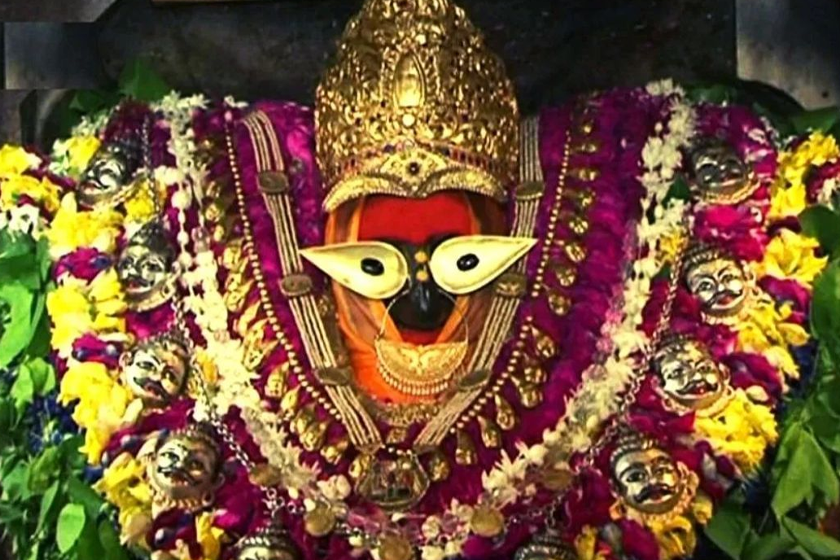Uttar Pradesh has long been a centre of spiritual travel, home to some of the most significant pilgrimage routes in India. Among its sacred sites, the Shaktipeeths hold a distinct place. These are the sites where the parts of Goddess Sati’s body fell on Earth. Spread across the subcontinent, these sites are enshrined and worshipped with great reverence. A few of these temples are located across Uttar Pradesh. During our stay in Uttar Pradesh, we covered these divine Shaktipeeths. Our journey through the state took us across towns and cities, following a trail marked by faith and lived traditions. Each temple offered a different experience, shaped by its setting and the people who continue to worship there.
Vishalakshi Temple, Varanasi
Our first stop was Varanasi, a city always vibrant, filled with the ringing of temple bells and quiet chants. Among the many shrines across the city lanes, we visited the Vishalakshi Temple, tucked away, near Mir Ghat in the old city. Recognised as one of the Shaktipeeths, it is believed to be the place where the kundala (earrings) of Goddess Sati fell. The approach to the temple took us through narrow, busy lanes lined with shops selling flowers, religious items, and everyday essentials. The sound of chants and bells occasionally rose above the hum of activity around us. Inside, the sanctum housed the image of Goddess Vishalakshi, adorned with garlands and offerings. The idol was richly decorated and the ceiling and walls painted in bright colours, decorated with ornamental details.
Vindhyavasini Temple, Vindhyachal
From Varanasi, we travelled to Vindhyachal, in the Mirzapur district, to visit the Vindhyavasini Temple, a prominent pilgrimage site said to be the place where the left toe of Goddess Sati fell. The temple is located near the banks of River Ganga, surrounded by narrow streets lined with shops. The area was busy, with pilgrims arriving from nearby regions and participating in the Trikon Parikrama, which connects Vindhyavasini Devi with the Ashtabhuja and Kali Khoh temples. The entrance to the temple led directly into a spacious inner courtyard. The sanctum housed the idol of Goddess Vindhyavasini, richly adorned with fresh garlands, ornaments and bright fabrics. The ongoing rituals, sound of bells and chants reverberated the air, making the experience truly immersive.
Lalita Devi Temple, Prayagraj
From Mirzapur we went to Prayagraj, where our next stop was the Lalita Devi Temple. This temple is regarded as a Shaktipeeth, believed to be the spot where the fingers of Goddess Sati are said to have fallen. Located near Bargad Ghat, one of the scenic riverfronts of the city, the temple had a quiet and serene atmosphere. Inside, the idol of Goddess Lalita Devi was adorned with flowers, fabric, and other ritual offerings. The temple complex was clean and open, with smaller shrines around the main sanctum and shaded spaces where devotees sat after offering prayers.
Katyayani Temple, Vrindavan
Our last stop was Vrindavan, a town closely associated with the worship of Lord Krishna. Amid its many temples, we visited the Katyayani Temple, where the hair of Goddess Sati is said to have fallen. Located near the popular Rangnath Temple, the Katyayani temple is lesser known, with calm and peaceful surroundings. The entrance of the temple leads to a courtyard bordered by trees, with the shrine at the centre. The idol of the goddess was adorned with bright colourful fabric and garlands, with the priests carrying out the daily rituals. The temple’s quiet setting and steady pace offered us a quiet space for worship in the bustling city of Vrindavan.
Our journey through the Shaktipeeths of Uttar Pradesh left us with a sense of reverence and reflection. Each temple, rooted in centuries of belief, offered not just a place of worship but a deeper connection to the living traditions of the region. As we stepped out of each shrine, what remained with us was the enduring faith, the distinct atmosphere of every place, and the powerful presence of the goddess in many forms, welcoming, fierce, and eternal.


